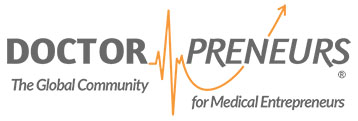It is no secret that the pace of the technology revolution is changing our daily lives rapidly. Companies such as Amazon are leading the way with innovative ideas. We are in the age of start-ups, platforms and the gig economy. Whilst healthcare is lagging behind this creates a market opportunity for doctors to lead in this inevitable transformation before we are disrupted by sectors which have less of an insight into healthcare than we do.
Disruptive companies such as Air BnB, Uber and Facebook have changed the way we interact, have changed the market and provided intense competition to the traditional companies in their respective markets. A disruptive innovation is one that creates a new market or value network starting at the bottom of an existing market and then eventually displaces the leading companies existing market or changing the market. The advance of technology and the internet of things is driving disruption today.

Disruptive innovators at the bottom of the market are likely to target a whole new consumer market that had been previously priced out by the sustaining innovations made by the market incumbents. Credit: Clayton Christensen
Clayton Christensen the esteemed professor at Harvard Business School postulated the theory of disruptive innovation and most recently the Jobs to be done theory. He outlines how we can’t reach solutions solely based on assumptions, analysis and research alone but we need to understand the individual reasons behind why people do certain things. He suggests that we ‘hire’ products to fulfil ‘jobs’. For example, people more likely to smoke might have a certain demographic background but those characteristics might have nothing to do with the reason they are smoking.
Whilst one person might ‘hire’ cigarettes to pass time another person might be using them to stop themselves from overindulging in food. The reasons people ‘hire’ different things can be to fulfil a variety of ‘jobs’ that may have nothing to do with the effect or the primary function of the product. Subsequently, whilst one might think cigarettes are competing with other tobacco products or alcohol in reality they could be competing with TV, books, the gym, food and even people.
Whilst one person might ‘hire’ cigarettes to pass time another person might be using them to stop themselves from overindulging in food
This is because some people, might smoke when they are bored, here they are using cigarettes as a form of entertainment. However, others might need it as a substitute to stop them eating high fat foods. Therefore, cigarettes are replacing other products and activities that can be used or done instead. This way of thinking in healthcare would enable us to disrupt and think more broadly about what needs to be done to make the alternative healthier habits more appealing to patients. In order to keep up with the increasing demands of healthcare it is time we start to apply concepts from other industries to our sector.
Five important areas leading to disruption
A lecture I recently listened to by Scott Anthony on Harvard Business Review Live outlined 5 important areas leading disruption. I will outline how they can be applied in the health industry.
1) Robotics and Drones
The automation of most processes allows us to operate in a more flexible way and in ways we couldn’t imagine before. The use of drones are being tested to deliver products by companies such as Amazon employing concepts such predictive analytics. Imagine a drone delivering your prescription medications to your doorstep or collecting a urine sample.
2) 3-D printing, additive manufacturing
This is a method of manufacturing to create physical objects based on a digital blueprint. This can allow mass customisation, allowing the creation for more personalised products for patients such as hearing aids. The main focus of this technology will be on printing human tissue in order to manufacture human organs. Additive manufacturing has the potential to let us invent new concepts which weren’t previously viable and will allow us to practice precision medicine.
3) Smart connected devices
The expansion of the Internet of Things has led to the creation of wearables and connected devices which enable us to exchange data in a network. This allows for seamless integration between different parts of a network and is very useful for health monitoring. By the use of sensors and apps we will be able to measure an increasing number of patient metrics (heart rate, blood pressure, activity levels, medication compliance, blood sugar, temperature etc) before the patient steps into a clinical setting. This allows the doctor to have more accurate information and could lead to better outcomes for patients. Google is making a smart contact lens which can measure your blood glucose and displays it on an app instantly which stops the needs for regular blood tests.
The possibilities are endless and will be great for monitoring patients remotely, allowing physicians to get health reports and intervene when required without seeing the patient.
4) Quantified self, Big analytics
Life-logging is becoming increasingly popular which allows people to input or measure aspects of their daily life such as calorie intake, sleep health, steps taken and even mood. Companies such as Nike and Fitbit make this easier by producing wearables which can track such information constantly that can be displayed via apps on your smartphone. The ‘Big Data’ we will have access to will enable us to identify trends like never before predicting the outcomes of patients. It is an ever growing market worth an estimated 67 billion dollars by 2021.
5) Services, Platforms
Everywhere industry today is being disrupted by companies providing platforms (digital markets where buyers and sellers meet). We can look at Uber, Air BnB, Deliveroo, Facebook: they all are platforms which benefit from network effects. Medicine will also be dominated by platforms sooner rather than later. There is a need for patients to get instant medical advice that suit their lifestyles. The digital doctor is becoming a reality, Babylon is a company leading the way with telemedicine consultations. The ease of using apps to connect doctors to patients will be utilised in an increasing number of medical settings.
Moreover, a truly disruptive innovation makes more affordable products and opens them up to a whole new customer base. In addition to the 5 areas listed above, the advances in Artificial Intelligence and Machine learning alongside Virtual reality and Augmented reality will really change the way healthcare is delivered in the future.
Core steps in order to to successfully lead the transformation in healthcare
1. Courage to chose to transform before we encounter problems and the existing system collapses.
2. Clarity to focus on carefully selected strategies which fulfil a ‘job to be done’ or embrace a ‘technology’.
3. Curiosity to explore despite failure.
4. Conviction to persevere.
Remember that when you struggle you innovate and one should look to fail fast and fail often in order to achieve better outcomes.The world is changing too quickly for us to not employ concepts such as design thinking in healthcare. It’s time we seize the moment in healthcare and embrace these advancements becoming enablers for the successful diffusion of innovation.

